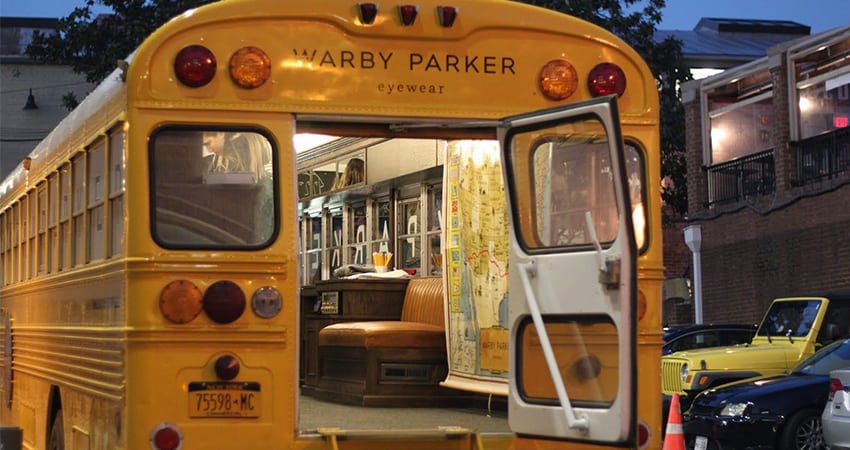Eyewear brand Warby Parker continues to disrupt its sector by offering affordable products both online and offline, innovating and taking a “do well by doing good” approach, its co-founder and CEO told an audience at IRCE in Chicago.
Dave Gilboa was still a graduate student in 2010 when he and co-founder Neil Blumenthal launched the company out of their apartments.
“The idea was really based on two simple premises,” Gilboa said. “One is that a pair of glasses should not cost more than an iPhone, and two, that eyeglasses could effectively be sold online.”
Gilboa said he and Blumenthal looked at the massive eyewear market, pegged at over $100 billion globally and $30 billion in the U.S., and decided there was a great opportunity to shake things up, challenging market leader Luxottica through innovation and creation of a more affordable product.
As ecommerce was beginning to take off, they decided to create a vertically integrated brand by manufacturing high-quality glasses and selling them direct online. The company’s policy of letting customers try on five pairs, including a return shipping label, has proven a tremendous hit.
“We were excited to bring innovation to an industry we thought needed it, and to create a for-profit business that did good in the world,” Gilboa said. “Since day one we’ve been carbon neutral and really focused on reducing our environmental impact.”
Warby Parker has also been a leader in philanthropic efforts. For every pair of glasses sold it donates a pair to nonprofit partners who distribute them worldwide, 4 million to date. And its “People’s Project” provides vision care and glasses to school-aged children in their classrooms, where teachers are often the first to spot issues.
“We estimate that there are 200,000 kids in New York City schools that need glasses but don’t wear them,” Gilboa said. “This year we’ll distribute 40,000 pairs of glasses to those children.”
Going from Click to Brick
Gilboa said adding stores to its ecommerce offerings was a natural progression for Warby Parker.
“For us we really focused on providing a great online experience but an offline as well,” said Gilboa. “We have 70 stores and we’ll have 90 by the end of the year. We can see a clear path to several hundred stores in addition to a thriving ecommerce business.”
Gilboa said one benefit of having stores is a rich source of in-person customer data. “We have learned so much from face-to-face conversations, feedback that from a purely digital relationship probably would have been impossible to get,” he said.
Warby Parker launched its first pop-up shop called the Holiday Spectacle Bazaar in a garage in SoHo, New York in 2013, a move viewed as crazy by industry observers. They then transformed an old school bus into a rolling store, driving around the country for 18 months and setting up pop-ups in 15 different cities. It also served as a live lab and location scouting exercise.
“In every city we made sure to park the bus in at least three or four different locations” Gilboa said. “We were generating sales but also testing the waters around which cities and which parts of these cities were most receptive for a more permanent location.” This exercise led to the opening of the first store in Washington D.C.’s Georgetown section.
Gilboa said the company learned that physical retail was far from dead – it just needed a creative makeover that enabled a fun experience for shoppers. Each store has its own design and personality reflective of the local market and audience, and the company created its own unified POS system.
“What we found from having both an online and offline experience is that people aren’t choosing one channel over the other,” he said. “We’re finding that 75% of people that buy something in our store have been to our website first. What they really value is convenience so we invested in technology to make the online and offline experience as convenient as possible.”
After noticing that many customers were coming into stores after a website or app visit, with the names of frames scribbled on pieces of paper, Warby Parker created the ability to favorite items, with the information immediately accessible to store associates.
“We also found the reverse was happening where a lot of people were trying on frames in our store but they weren’t quite ready to check out,” Gilboa said. “They didn’t know their insurance benefit or wanted to ask someone else’s opinion so they asked our team to write down the name of the frames they’re looking at.”
Now associates can take pictures of customers wearing a favorite frame, turn it into a digital bookmark they can send to the customer via email, and with one click add it to their cart.
Gilboa said Warby Parker’s ability to address customer needs has contributed to its net promoter score of 86, the highest in the industry and well above other categories.
Another innovation is Warby Parker’s “Find Your Fit” feature. Using an iPhone 10, shoppers can take measurements from 30,000 points on their face, leading to more accurate recommendations.
It also launched Prescription Check, a tele-health service in its app that allows an optometrist to assess a customer’s vision through a particular pair of glasses. Gilboa stressed this isn’t meant to replace eye exams. Doctors review the results and let customers know whether they need a full exam or just an updated prescription.

